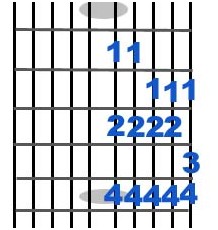







© 2011 Bob Culbertson
The Diatonic Scale
In this lesson we will study the application of one "master" pattern to create all of our major and minor scales.
Looking at FIG. 1 you will see the numbers 1-7 repeated in a 7 string pattern. Yes, I know your stick has only 5 or 6 melody strings. This pattern represents all possible combinations of scales in one pattern. All you do is line up the number one (1) on the root of the key you want to play in.
In this lesson we will study the application of one "master" pattern to create all of our major and minor scales.
Looking at FIG. 1 you will see the numbers 1-7 repeated in a 7 string pattern. Yes, I know your stick has only 5 or 6 melody strings. This pattern represents all possible combinations of scales in one pattern. All you do is line up the number one (1) on the root of the key you want to play in.

Fig 1
FIG. 2 shows an example of starting on the 13th fret (the note G) and playing the pattern beginning with the note (1) lined up with (G). This puts you in the 1st position for the key of (G). If you want to play the next position in (G) just start on the 15th fret and begin with the part of the pattern that begins with the note numbered (2). FIG 3 shows this pattern. This is an endless looping pattern so you can play any position for any key as long as you line up the appropriate number with where you are in the key. *Note: you can start on any (1) it does not have to be the first finger.
Fig 2
One other example is if you wanted to play in the key of (G minor) line up the number (6) with the note (G). Then continue the pattern
I use several fingerings for these patterns. Some players use their 4th finger for the highest note on each string. Others use their 3rd finger. The 4th finger method is a good place to start. I have found myself using both, and feel strongly that each method has its own advantages. It is recommended that you eventually learn both proficiently. Below is a diagram of both fingerings.
I use several fingerings for these patterns. Some players use their 4th finger for the highest note on each string. Others use their 3rd finger. The 4th finger method is a good place to start. I have found myself using both, and feel strongly that each method has its own advantages. It is recommended that you eventually learn both proficiently. Below is a diagram of both fingerings.



Fig 3


Fig 4
Fig 5